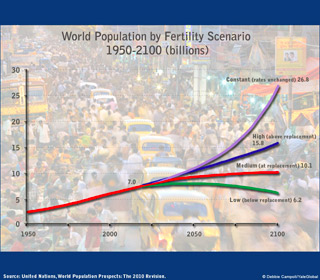Global Population of 10 Billion by 2100? – Not So Fast
Global Population of 10 Billion by 2100? – Not So Fast

NEW YORK: By UN calculations, on October 31, the world’s population will hit 7 billion, twice the total 44 years ago and triple the population 66 years ago. As the costs and benefits of this historic demographic milestone are debated in scientific journals and the popular media, a central question is in the minds of many: Will world population double or triple again, or could it peak in the near future and even decline? The state of the world will depend largely on the answer to this question.
Barring a cataclysmic global mortality disaster decimating humanity, world population depends largely on fertility in the coming decades. If women on average have slightly more than two children, then the world population eventually stabilizes.
However, if women on average have more or less than the replacement rate of 2.1 children, then over the long term, the world population would increase or decline, respectively. Simply stated, replacement fertility is essentially the tipping point for world population.
One possible scenario – unlikely, yet instructive – is the fertility rates of countries remaining unchanged at current levels. Under this assumption, world population would nearly quadruple, as it did during the 20th century, to 26.8 billion inhabitants by 2100, and grow by an incredible 600 million annually, about eight times today’s yearly increase.
Constant fertility rates can lead to demographically problematic outcomes. At one extreme, the populations of high-fertility countries, such as Mali, Niger and Uganda, would increase enormously, roughly 30 to 40 times by 2100, and half of their populations would be children below 15 years old. At the other extreme, the populations of low-fertility nations, such as Germany, Japan and Russia, would see their populations shrink by 2100, declining to about half their current sizes, and about half their populations would be citizens aged 60 years and older.
Taking into account past fertility trends for a given country plus the past experiences of all other countries in the world, United Nations population projections rely on a probabilistic model that generates thousands of possible trajectories to derive the future median paths of fertility for individual nations and territories. Assuming likely improvements in mortality rates and expected levels of international migration for individual countries, future world population is then simply the aggregation of the country-specific projections – basically future births minus deaths plus the net number of migrants.
The most widely used and frequently cited scenario for future world population is a UN medium projection. It assumes future fertility rates will converge – from above or below – nearing the replacement level of about two children per woman. Accordingly, the world population in 2100 is expected to be near stabilization at around 10.1 billion.
To reflect the uncertainty of future fertility, the United Nations also publishes two less publicized projections, assuming higher or lower fertility rates: With an average of 2.5 children per woman, the world population would be 15.8 billion; with 1.5 children per woman, the world would return to 6.2 billion inhabitants.

Enlarge ImageFigure 1. World Population by Fertility Scenario
How likely is it that over the long term countries will reach and settle at the magical demographic balance point of replacement fertility of about two children per woman? Will today’s high-fertility nations, such as Mali, Niger and Uganda, which on average have more than six children per woman, see fertility drop to near replacement levels by the close of the century? Similarly, will current low-fertility countries, such as Germany, Japan and Russia with rates below 1.5 children per woman, experience sufficient fertility gains to reach replacement level by 2100?
The recent downward trend in fertility is unequivocal. At the start of the 20th century average global fertility was about six children per woman. By 1950 world fertility had declined to five children per woman and no country had levels below two children per woman. Over subsequent decades the downward trend in fertility accelerated, and today’s average world fertility stands at 2.5 children per woman. Moreover, 60 countries –as varied as China, Brazil, Russia, Japan, Vietnam, Germany, Iran, Thailand and France – have fertility below two children per woman, representing 42 percent of world population.
Admittedly, it is difficult to imagine such rapid transitions in today’s high-fertility countries in sub-Saharan Africa and Asia. However, rapid transitions from high to low fertility levels have occurred in diverse social, economic and political settings, including Albania, Algeria, Brazil, China, Costa Rica, Iran, Mexico, Thailand, Tunisia, Turkey and Vietnam – and could happen in other high-fertility countries over the coming decades.
In contrast, the assumption that the fertility of below-replacement nations will return to replacement levels appears dubious. While a future rebound cannot be ruled out – for example, rates rebounded in some European nations after WWII – the general pattern over the last half century has been unmistakable: Once fertility falls below the replacement level, it tends to stay there – especially the case for scores of countries where fertility has declined below 1.5 children per woman, such as Canada, Germany, Hungary, Italy, Japan, Russia and South Korea.
Aiming to raise very low fertility rates, viewed as jeopardizing the basic foundations of the nation and its survival, some European and Asian countries have adopted family-friendly policies, incentives and programs. However, based on past experience and the numerous constraints governments face in this area of human behavior, few researchers expect such pronatalist efforts to be sufficient in raising fertility to replacement levels.
Powerful forces were responsible for reducing fertility in the past, including lower mortality rates, urbanization, education, delayed marriage and childbearing, improvements in the status of women and widespread use of contraceptives. Additional forces keeping fertility low – often below two children per woman – are the decline of marriage, divorce and separation, co-habitation, employment and economic independence of women, costs of childrearing, childless lifestyles and the need to save for longer years of retirement and elder care.
Most population specialists anticipate that future fertility levels will most likely fall somewhere between 2.5 and 1.5 children per woman, the range of the UN high- and low-projection scenarios. Many may also agree, or at least appreciate, that it’s demographically convenient to have the frequently cited UN medium-scenario projection assume fertility rates eventually reaching and settling near the replacement level of two children per woman. The assumption leads to population stabilization, thereby avoiding demographically and politically problematic outcomes.
However, other than the demographic expediency and political acceptability of population stabilization, there appears to be little, if any, empirical or theoretical rationale for the widely cited UN projections to assume convergence to replacement level fertility. Resting on the dubious assumption of convergence to replacement fertility, the weighty message to scholars, government officials and the general public that world population is expected to approach stabilization at 10 billion by the end of the century appears tenuous.
The demographic patterns observed throughout Europe, East Asia and numerous other places during the past half century as well as the continuing decline in birth rates in other nations strongly points to one conclusion: The downward global trend in fertility may likely converge to below-replacement levels during this century. The implications of such a change in the assumptions regarding future fertility, affecting as it will consumption of food and energy, would be far reaching for climate change, biodiversity, the environment, water supplies and international migration. Most notably, the world population could peak sooner and begin declining well below the 10 billion currently projected for the close of the 21st century.